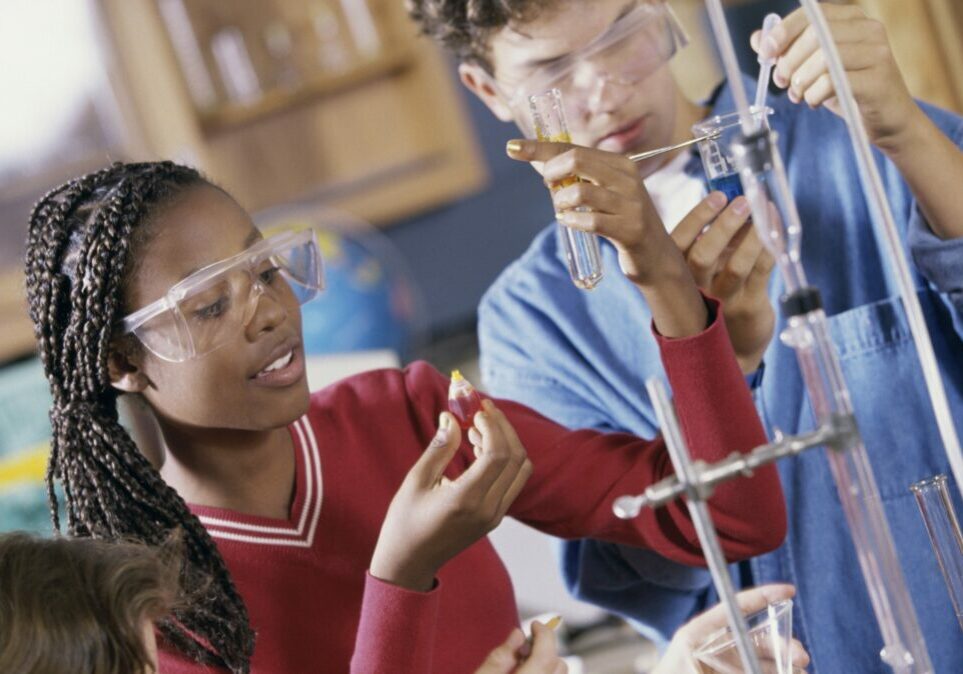Published in the January 2016 NJEA Review
by Adrienne Markowitz and Eileen Senn
Educational chemical demonstrations in the lab or classroom are valuable in that they help teach important science concepts in ways that make lasting impressions and help inspire students to become involved in science. But flammable liquids such as methanol or other alcohols used in such demonstrations are capable of igniting and forming fires that can cause severe burn injuries and property damage.
In yet another preventable science lab fire, five students and their teacher were injured at W.T. Woodson High School in Fairfax County, Va. on Oct. 30. A chemistry demonstration went out of control with a flash of flame engulfing a group of students, leaving two with serious burns and sending three others to the hospital. Unfortunately, the accident at Woodson is just one of many that occur around the country.
Every one of these events could have been prevented. The root problem is school districts shirking their responsibility to develop and adopt comprehensive lab safety programs despite long-standing legal requirements to do so.
Pressure on school districts is ramping up as outrage over student and teacher burn victims increases. In response to three serious accidents over an eight-week period in 2014, the U.S. Chemical Safety Board (CSB), an independent federal agency, issued a strongly worded safety bulletin. The National Fire Protection Association (NFPA) added requirements for students to the 2014 edition of their lab fire prevention standard. And the National Science Teachers Association (NSTA) issued a safety alert and position statement after the Woodson High School incident. These are listed along with other resources under “For more information.”
“Incidents such as the one at Woodson High School reinforce the common sense lessons articulated in the CSB’s 2014 safety bulletin,” stated CSB board member Kristen Kulinowski, who holds a doctorate in chemistry and has experience as a chemical educator. “Teachers can demonstrate the same chemistry principles in an inherently safer way by minimizing or even eliminating the use of bulk solvents near open flames.”
Demand the best protective measures
It is imperative that local associations work with their UniServ field representatives to make sure administrators are providing the most effective protective measures possible to control lab fire hazards. The best solutions are those that permanently eliminate or correct hazards at their source. Less desirable are those that require members to use protective equipment or fight fires. Sometimes, short-term solutions will be needed until money can be obtained for longer-term repairs. Critical to any plan is a commitment to a deadline from the district for each proposed improvement.
Use CSB and NFPA recommendations
Among the key recommendations that local associations can cite are:
- Containers of flammable chemicals should not be in close proximity to potential ignition sources such as open flames.
- Employers should implement strict safety controls when lab demonstrations include handling hazardous materials.
- Prior to performing any activity with flammable chemicals, conduct a thorough hazard review.
- Provide a safety barrier between any activity involving flammable chemicals and any audience or bystanders.
- Any person inside the barrier during a chemical demonstration activity must wear all appropriate personal protective equipment.
Use PEOSH standards
Local associations can make good use of the Public Employees Occupational Safety and Health (PEOSH) Laboratory standard, 29 CFR 1910.1450, adopted in 1990 and updated in 2011. The PEOSH Right to Know (RTK) and Hazard Communication standards would also apply. See the May 2013 NJEA Reporter article, “Manage lab chemicals safely,” for all the PEOSH standards that school districts must follow to ensure lab safety.
Use NSTA position statement
Locals can also make good use of the 2015 NSTA position statement on safety and school science instruction. Among many excellent recommendations, the most useful may be those concerning occupancy load and overcrowding in labs, the need for one adult to supervise every 24 students, and the need to provide adequate individual student workspace areas. It cites research showing that accidents rise dramatically as class enrollments exceed 24 students or when inadequate individual workspace is provided.
- Most Effective
- Eliminate the hazard – Perform demonstrations that do not use hazardous chemicals or use minimal amounts. Use video demonstrations.
- Substitute something less dangerous – Use chemicals that are less hazardous.
- Safeguarding technology – Perform demonstrations in lab hoods or behind barriers.
- Training and procedures – Conduct a safety review, prepare written procedures, train teachers and students.
- Least Effective
- Personal protective equipment such as goggles, gloves, aprons.
- Fire response equipment such as sand buckets, blankets, extinguishers.
- Emergency eyewash stations and showers.
For more information
“After the Rainbow,” December 2013, five-minute video, U.S. Chemical Safety Board. Features a student burn victim from a rainbow experiment. www.csb.gov/videos/after-the-rainbow
“Unsafe Science,” by Andrew Minister, protection engineer, October 2015, NFPA Journal. Unsafe Science
“NFPA 45: Fire Protection for Laboratories Using Chemicals,” November 2014, National Fire Prevention Association. Free access with registration. https://bit.ly/chemfireprotection
“NSTA Urges Science Educators to Halt the Use of Methanol-Based Flame Tests on Open Laboratory Desks,” Nov. 4, 2015, two pages, National Science Teachers Association. https://bit.ly/methanolflametests
“Safety and School Science Instruction: An NSTA Position Statement,”2015, six pages, National Science Teachers Association. www.nsta.org/docs/PositionStatement_Safety.pdf
OSHA Health and Safety Topic Page on Laboratories. www.osha.gov/SLTC/laboratories/standards.html
Adrienne Markowitz holds a Master of Science in Industrial Hygiene from Hunter College, City University of New York. Eileen Senn holds a Master of Science in Occupational Health from Temple University in Philadelphia. They are consultants with the New Jersey Work Environment Council, which is a frequent partner with NJEA on school health and safety concerns.
